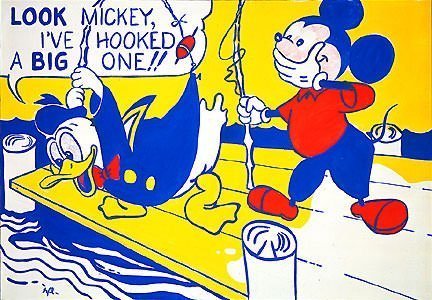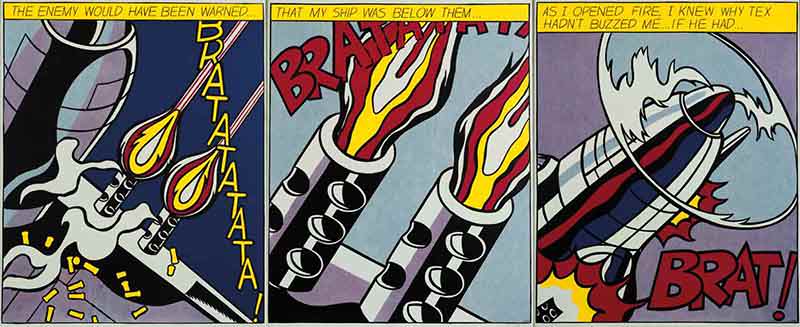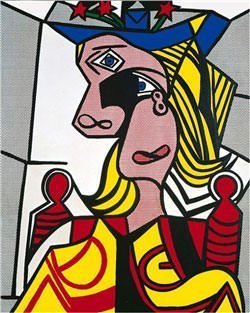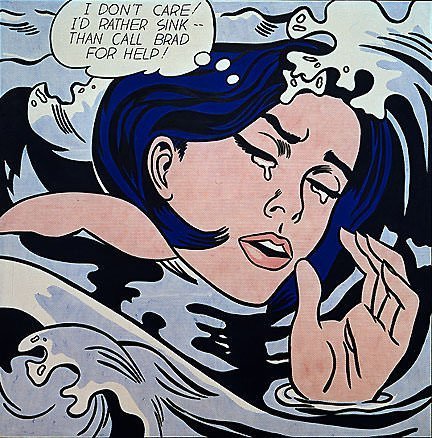Monday, December 1, 2014
Wednesday, November 19, 2014
Wednesday, November 5, 2014
Thursday, October 23, 2014
Roy Lichtenstein
http://learnodo-newtonic.com/roy-lichtenstein-facts
#1 Initially Roy Lichtenstein was not a comic book enthusiast

Look Mickey by Roy Lichtenstein

As I Opened Fire by Roy Lichtenstein

A Detail from Roy Lichtenstein’s ‘Three Landscapes’

Woman with Flowered Hat by Roy Lichtenstein

Drowning Girl by Roy Lichtenstein
The Ben-Day dots printing process, named after illustrator and printer Benjamin Henry Day, Jr. is a technique dating from 1879. Depending on the effect, color and optical illusions needed, small colored dots are closely spaced, widely spaced or overlapping. Magenta dots, for example, are widely spaced to create pink. Pulp comic books of the 1950s and 1960s used Ben-Day dots in the four process colors to inexpensively create shading and secondary colors such as green, purple, orange and flesh tones.
Warhol was a printmaker- he created screen print artworks on paper in mass production.
His work focused on consumerism and popular culture, like Coca Cola, Campbells Soup, or Brillo.
Lichtenstein's work was primarily on canvas. He worked with paints.
He's famous for his benday dots- those tiny circles that create shade and shadow in his art.
No other pop artist used these dots.
#1 Initially Roy Lichtenstein was not a comic book enthusiast
Roy Lichtenstein was born on October 27, 1923 in a Jewish family. As a boy he was not a comic book fan although later, comic strips would provide inspiration for his best known works.
#2 He started as a Cubist Artist
Roy Lichtenstein’s initially worked in Cubism and Abstract Expressionism. By late 1950s, however, his works included hidden images of cartoon characters.
#3 His son drove him towards Pop Art
His 1961 painting Look Mickey is regarded as the bridge between his Abstract Expressionism and Pop Art works. He created the painting after his son challenged him by pointing out to a Mickey Mouse comic book and saying, “I bet you can’t paint as good as that, eh, Dad?”

#4 Art critics severely criticized his work and called him a copycat
First time his work was exhibited it was heavily criticized by art critics and the Life magazine went to the extent of publishing an article whose title asked “Is He the Worst Artist in the U.S.?” Lichtenstein was also called a copycat by many as his works closely resembled the originals. With time, however, he was considered as one of the greatest artists of the Pop Art Movement.

#5 ‘Whaam!’ is Roy Lichtenstein’s most famous painting
Lichtenstein’s ‘Whaam!’ is an iconic work of the Pop Art movement and perhaps his most famous painting. ‘Whaam!’ is one of the several works by Roy which depict aerial combat. Lichtenstein had a three year stint in the United States army from 1943 to 1946. During that stint, he was sent to pilot training but the program was cancelled. The other monumental war painting by Lichtenstein is ‘As I Opened Fire’.
#6 The cartoon artist of ‘Whaam!’ helped Roy during his stint in the army
The original artist of ‘Whaam!’ was American comic-book illustrator Irv Novick, who incidentally, was an officer at the army boot camp where Lichtenstein trained during the Second World War. After recognizing Roy’s talent Novick had moved Roy from latrine-mopping duty and got him designing signs and posters instead. Ironically, years later, Lichtenstein turned his illustration into a masterpiece.



His work focused on consumerism and popular culture, like Coca Cola, Campbells Soup, or Brillo.
Lichtenstein's work was primarily on canvas. He worked with paints.
He's famous for his benday dots- those tiny circles that create shade and shadow in his art.
No other pop artist used these dots.
Friday, October 17, 2014
Thursday, October 16, 2014
Andy Warhol- POP ART
- Pop art is an art movement that emerged in the mid-1950s in Britain and in the late 1950s in the United States. Pop art presented a challenge to traditions of fine art by including imagery from popular culture such as advertising, news, etc.
Facts:1. A devout Roman Catholic, Warhol attended mass daily2. The blank right-hand side of Warhol's Silver Car Crash mimics the breaking of a strip of projected film and the loss of consciousness upon death.3. In 1964 the Castelli Gallery showed Warhol's Flowers series, a theme the artist selected in part because the art dealer Ileana Sonnabend sensed New York collectors' resistance to his early Death and Disaster paintings, which had been more popular in Europe.4. Warhol started to paint depictions of Elizabeth Taylor when the actress got sick while filming Cleopatra and the artist believed she might die.
Wednesday, October 8, 2014
Photo Montage
Photomontage is the process and the result of making a composite photograph by cutting and joining two or more photographs into an illusion of an unreal subject.
Friday, September 26, 2014
Tuesday, September 23, 2014
CUBISM
CUBISM!
traditional ideas of painting such as proportions and perspective were abandoned in favour of a minds eye or total view of an object.
There were two stages of cubism, first came Synthetic Cubism between 1907-
usualy has multiple views of an object. (i.e. two eyes on one side of a face, seeing all sides of a chair, ect.)
traditional ideas of painting such as proportions and perspective were abandoned in favour of a minds eye or total view of an object.
There were two stages of cubism, first came Synthetic Cubism between 1907-
usualy has multiple views of an object. (i.e. two eyes on one side of a face, seeing all sides of a chair, ect.)
Friday, September 19, 2014
Monday, September 15, 2014
Chuck Close
Chuck Close was born on July 5, 1940, in Monroe, Washington.
Suffering from severe dyslexia, Close did poorly in school but found solace in making art.
Close eventually enrolled at the University of Washington, graduating in 1962 and immediately heading east to Yale to study for a Master of Fine Arts from the university's Art and Architecture School.
His pieces blurred the distinction between painting and photography in a way that had never been done before. His techniques too were noteworthy, in particular his application of color, which helped pave the way for the development of the inkjet printer.
By the late 1960s, Close and his photo-realist pieces were entrenched in the New York City art scene. One of his best-known subjects from that period was of another young artistic talent, composer Philip Glass, whose portrait Close painted and showed in 1969.
Suffering from severe dyslexia, Close did poorly in school but found solace in making art.
Close eventually enrolled at the University of Washington, graduating in 1962 and immediately heading east to Yale to study for a Master of Fine Arts from the university's Art and Architecture School.
His pieces blurred the distinction between painting and photography in a way that had never been done before. His techniques too were noteworthy, in particular his application of color, which helped pave the way for the development of the inkjet printer.
By the late 1960s, Close and his photo-realist pieces were entrenched in the New York City art scene. One of his best-known subjects from that period was of another young artistic talent, composer Philip Glass, whose portrait Close painted and showed in 1969.
Friday, September 12, 2014
Subscribe to:
Posts (Atom)














































